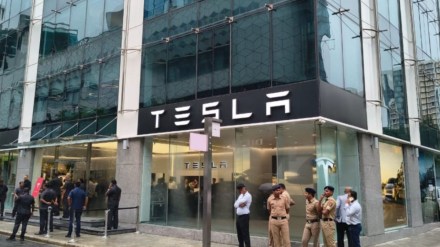After years of speculation, lobbying and negotiations, Tesla has finally entered India, albeit not in the manner the government would have wanted. Much like its approach with Apple, the government hoped to woo the US electric vehicle (EV) giant into establishing a manufacturing base in India, positioning the country as a global production hub. But Tesla, unlike Apple, resisted it, pushing instead for a reduction in import duties as a precondition to testing the waters. The Apple comparison is instructive. Both are iconic US-based companies with deeply entrenched manufacturing footprints in China.
Apple began its India production journey around five years ago, on the back of the government’s production-linked incentive (PLI) scheme. That bet has paid off handsomely. In FY25, India now accounts for nearly 20% of global iPhone production, roughly 40 million units valued at $22 billion. Of these, about 80% were exported to key markets like the US and Europe. Apple CEO Tim Cook even declared that a majority of iPhones sold in the US this past quarter would be assembled in India, which even earned him a public rebuke from US President Donald Trump.
The government hoped for a similar success story with Tesla. Yet while Apple got a well-calibrated policy with financial incentives to ease its China-to-India shift, Tesla was handed an EV policy that asked for a $500-million investment and a bank guarantee of equal size, with the added risk of forfeiture if localisation targets weren’t met within three years. For a company that wanted to first assess the market before committing, the policy was more a deterrent than an incentive. The EV policy was in many ways a response to Tesla’s persistent lobbying for lower import duties, which ranges between 70% and 100%. But by the time the final contours emerged, the moment may have passed. Ongoing trade negotiations with the US, and more crucially the India-UK free trade agreement that slashed duties for British luxury cars, had already created parallel routes for market access. In contrast, the EV policy seemed cumbersome. What Tesla wanted was a stepping stone, but what it was getting was bureaucratic red tape.
The policy’s design also appears not to have been preceded by widespread industry consultations, as none of the global automakers like Mercedes-Benz, Volkswagen, Škoda, Hyundai, and Kia have responded to it. Therefore, Tesla’s current India presence is symbolic at best. The launch of the Model Y, imported from its Shanghai gigafactory, the company’s largest plant globally, marks a late but calculated entry. Priced at Rs 59.89 lakh and Rs 67.89 lakh for the two variants, the Model Y competes in a crowded luxury EV segment. But the 70% import duty makes it one of the most expensive Tesla models globally, nearly 30% more than its US price. A 3,000 sq ft experience centre in Mumbai, with another set to open in Delhi, along with a sparse supercharger network, signals intent without volume.
India is anyway not a volume story for Tesla. Much like Apple, the real strategic value lies in India’s potential as a manufacturing hub for global exports. But the EV policy failed to incentivise on that front. As a result, for now, both sides appear to have settled for a token presence, which is a beginning that is neither here nor there. Whether this leads to deeper engagement or simply remains a showroom exercise will depend on whether the two sides agree to come to the drawing board again.
